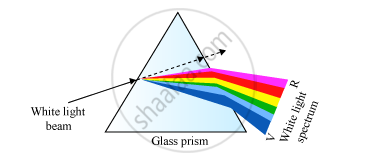Advertisements
Advertisements
प्रश्न
What is a dispersion of light
उत्तर
Dispersion of light is the phenomenon of splitting of light into its component colours.
When a narrow beam of sunlight is incident on a glass prism, the emergent light splits into seven colours, namely, violet (V), indigo (I), blue (B), green (G), yellow (Y), orange (O) and red (R).

संबंधित प्रश्न
A ray of light passes through an equilateral glass prism such that the angle of incidence is equal to the angle of emergence and each of these angles is equal to 3/4 of angle of prism. Find the angle of deviation.
For any prism, prove that :
'n' or `mu = sin((A + delta_m)/2)/sin(A/2)`
where the terms have their usual meaning
Describe an activity to show that the colours of white light splitted by a glass prism can be recombined to get white light by another identical glass prism. Also, draw a ray diagram to show the recombination of the spectrum of white light.
If three identical prisms are combined, is it possible to pass a beam that emerges undeviated? Undispersed?
A thin prism is made of a material having refractive indices 1.61 and 1.65 for red and violet light. The dispersive power of the material is 0.07. It is found that a beam of yellow light passing through the prism suffers a minimum deviation of 4.0° in favourable conditions. Calculate the angle of the prism.
A ray of light is incident on a prism whose refractive index is 1.52 at an angle of 40°. If the angle of emergence is 60°, calculate the angle of the prism.
An equilateral glass prism has a refractive index 1.6 in the air. Calculate the angle of minimum deviation of the prism, when kept in a medium of refractive index `4sqrt(2)"/"5.`
How does the angle of minimum deviation of a glass prism vary if the incident violet light is replaced by red light?
Prove that in case of a prism, i + e = A + δ, where the symbols have their usual meanings.
What is meant by a thin prism?
